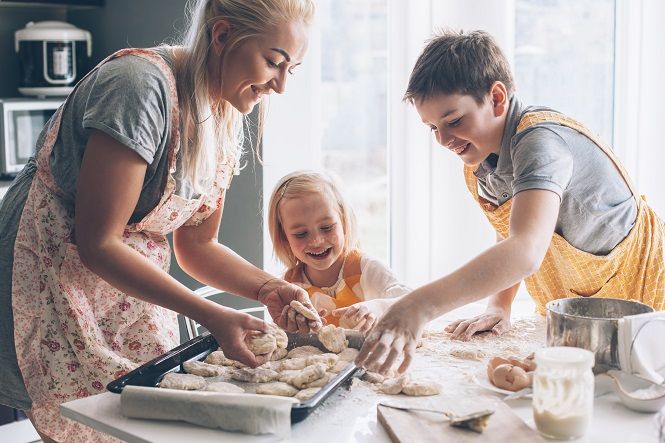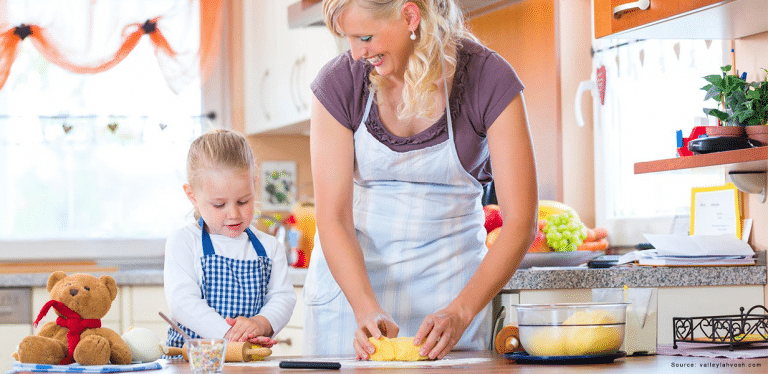In my experience, being an aunt has involved a number of things, like water fights, catching lightning bugs (fireflies, if you’re not familiar with the term), and decorating the porch with sidewalk chalk. But one of the most precious activities as an aunt, to me, has been baking with my sous-chefs. We’ve covered a variety of baked goods, and already we have great memories together that were made with cookie sheets and cupcake pans.

Obviously, continued efforts in one activity can lead to great learning experiences that make the process easier. For baking, these lessons and thoughts can be very simple ideas, but they create a more fun—and more efficient—experience to share with my dears while we bake up treats the whole family can enjoy.
If you’re interested in building your own baking memories with the little people in your life, keep reading to find 10 tips that will help make your baking moments better!
Take requests on what to bake. To understand how important this detail is, think about how annoying it would be to have your workday dictated moment by moment. Perhaps you stock shelves at a store, but you have to lift the items being stocked from your left side and spend only ten seconds on that item before you go to the next one. Sounds boring, right? But imagine if you were able to apply your own style to it, like listening to music and dancing your way through shelving. Sound better? More interesting? Well, apply that concept to baking with your kids, and you could see how allowing them the space to make a decision or two can create a more enjoyable environment. The point to baking with them is to enjoy the baking, after all, so give them the opportunity to contribute. Cookies, brownies, cakes, pies… If they have a say, the experience is more personal.

Be creative with your recipes. Particularly if you’re baking something like a cake from a box, simply following the instructions can become dull after a while. Don’t let your baking time with your kids be a bore! Rather, discuss with them what interesting twists they might like to have with the treat they’re going to bake, and brainstorm ideas about how to go about it. Add marshmallow crème to those brownies, peanut butter to that cake batter, or cinnamon to those vanilla cupcakes! The more interesting and complex the final product is, the prouder your kids could be.
Safety first! Once you have your ingredients and recipe ready, it’s time to think about the baking itself—and there’s no more important thing to consider when baking with kids than safety! Be certain you’re only giving them utensils to use that are age-appropriate, and make sure they keep their distance from too-hot areas that they might bump into—like a pan that just came out of the oven. Sure, you want your children to be a part of the process, but it’s important to consider their age so that they’re staying in safe territory. Only make good memories and delightful foods during your baking—not injuries!
Keep the area clean while you bake. While baking, your counters can get a little untidy. This isn’t the best thing for an adult trying to bake alone as you could run out of space or do something like accidentally put a plate of fully baked cookies on egg remnants (ew!), but it’s a bigger deal if you’re baking with kids for the aforementioned safety aspect. Too much clutter can be a fire hazard if your child just pushes something out of the way, so keep the area clean to prevent a catastrophe.

Be patient. Anyone who’s learning a new skill should have a space of time to learn how to go about that skill, and baking is no different—especially with children. They probably won’t do everything perfectly, and you’ll likely have to explain a thing or two to them as they go. If they accidentally pour too much sugar into the mix, don’t fuss at them! Just examine the problem, and see if there’s a way to counteract it. Even if there’s not, give them the space to make their mistakes and learn. Explain things to them when they have questions, and expect there to be some missteps.
Let them do what they can, and help them with other baking steps. As I said earlier, there’s an issue of safety with certain baking steps, but beyond safety details, other things might pose problems for younger children. An example is adding in a teaspoon of an ingredient. Your child might not have a steady enough grip on the spoon and ingredient to add just the right amount, so you might want to take that ask on yourself. But if your child can handle a detail safely, let them! If they want to mix the cake batter, hand over the mixer. If they want to add the peanuts to the brownies, show them how to stir them in. The more involved they can be, the more pride they could have in the final project.
Make sure your kids can reach the ba king supplies and equipment they’ll need. While you might decide that your child is fully capable of handling the mixer, it’s worth considering whether or not your child can reach the mixer. If not, you could end up with batter that isn’t smooth, or the bowl could tip over since your child has to stretch to reach it. That could create a very real—and very sizable—mess! Save yourself the trouble of cleaning up the batter later by lowering the bowl to where your child can easily reach it, or by boosting the child up by a step ladder to safely reach it that way. It’ll save you cleaning and keep you from losing your baked treats before they go into the oven.

Offer compliments and positive reinforcements. Your child might get a baking detail perfect on the first try—or the fifteenth! The point is that something has been done correctly, and the effort should be rewarded to keep them encouraged to grow even more as a baker. If they fill the measuring cup to the perfect level, tell them. If they manage to separate the egg white for the very first time, give them a high-five. By letting your child know they’ve been successful, you’re boosting their confidence in regard to baking.
Laugh off your mistakes. At those moments where something big happens that’s undoubtedly a mistake, don’t panic! Don’t fuss! Instead, smile—even laugh—to make sure your child knows that there’s no major harm done. Even if the brownies are ruined, there’s another batch that can be made at a later time, so don’t treat it like the end of the world. If your child pours too much milk in the batter, give a good laugh or a kind word to let the child know it’s okay—that mistakes happen. If you have to throw out the batter or dough, do so with a happy expression to keep your child from feeling discouraged. We’re looking for good memories here—not ones where an adult is complaining about an honest mistake!
Take pictures. You’re making good memories, remember? Don’t neglect documenting those memories by snapping a few photos during the baking process—maybe through the whole baking process, from buying the ingredients to eating a finished cupcake. Pick a baking-themed photo album to place the pictures in to round-out the experience, and be sure to get photos of your child doing things like gathering the ingredients, mixing the batter, or applying sprinkles. Especially for the first baking experience, this tip is important to keep the memories preserved to revisit as the years roll on.
With these tips in mind, you could have a wonderful baking experience with your children that encourages their creativity, makes them smile, and is documented as a treasured memory—one that ends with cookies, cakes, or brownies! All-around, it’s a wonderful takeaway!
Source – GiftsAndSpecialOccasions.com


